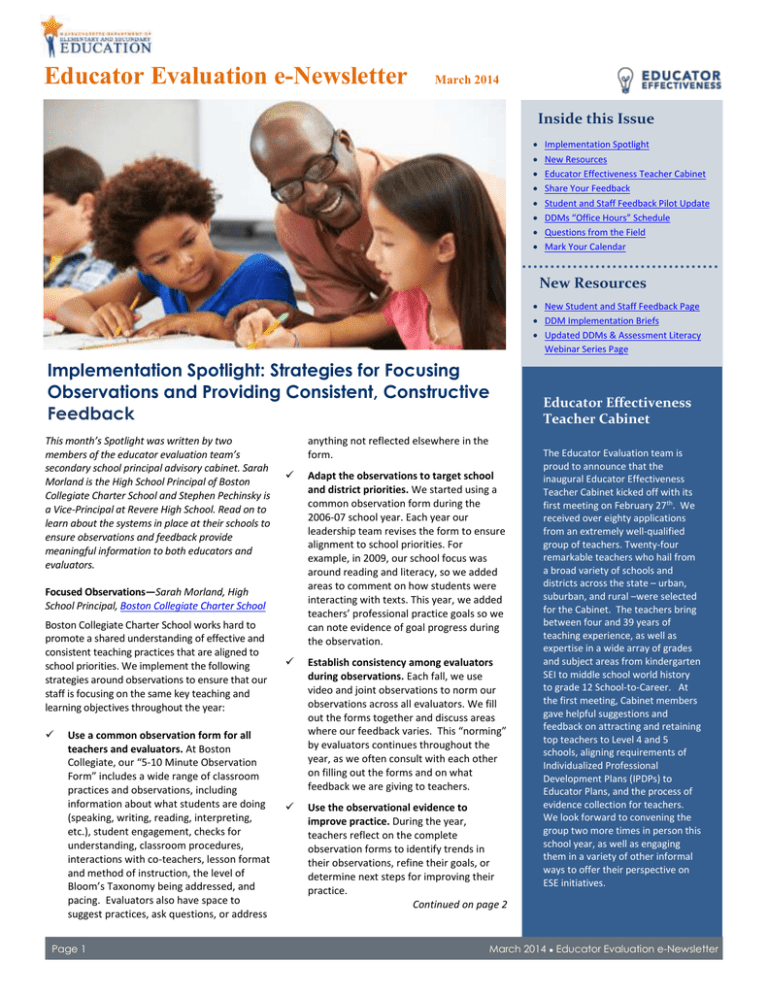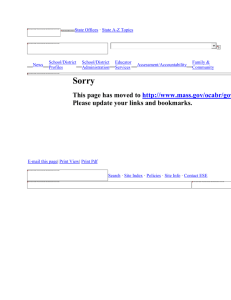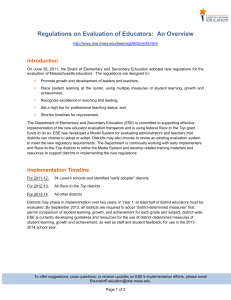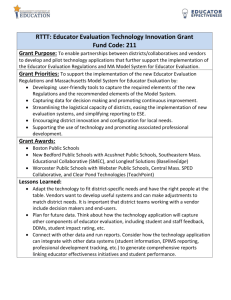2014 03
advertisement

Educator Evaluation e-Newsletter March 2014 Inside this Issue Implementation Spotlight New Resources Educator Effectiveness Teacher Cabinet Share Your Feedback Student and Staff Feedback Pilot Update DDMs “Office Hours” Schedule Questions from the Field Mark Your Calendar New Resources New Student and Staff Feedback Page DDM Implementation Briefs Updated DDMs & Assessment Literacy Webinar Series Page Implementation Spotlight: Strategies for Focusing Observations and Providing Consistent, Constructive Feedback This month’s Spotlight was written by two members of the educator evaluation team’s secondary school principal advisory cabinet. Sarah Morland is the High School Principal of Boston Collegiate Charter School and Stephen Pechinsky is a Vice-Principal at Revere High School. Read on to learn about the systems in place at their schools to ensure observations and feedback provide meaningful information to both educators and evaluators. anything not reflected elsewhere in the form. Adapt the observations to target school and district priorities. We started using a common observation form during the 2006-07 school year. Each year our leadership team revises the form to ensure alignment to school priorities. For example, in 2009, our school focus was around reading and literacy, so we added areas to comment on how students were interacting with texts. This year, we added teachers’ professional practice goals so we can note evidence of goal progress during the observation. Establish consistency among evaluators during observations. Each fall, we use video and joint observations to norm our observations across all evaluators. We fill out the forms together and discuss areas where our feedback varies. This “norming” by evaluators continues throughout the year, as we often consult with each other on filling out the forms and on what feedback we are giving to teachers. Use the observational evidence to improve practice. During the year, teachers reflect on the complete observation forms to identify trends in their observations, refine their goals, or determine next steps for improving their practice. Continued on page 2 Focused Observations—Sarah Morland, High School Principal, Boston Collegiate Charter School Boston Collegiate Charter School works hard to promote a shared understanding of effective and consistent teaching practices that are aligned to school priorities. We implement the following strategies around observations to ensure that our staff is focusing on the same key teaching and learning objectives throughout the year: Use a common observation form for all teachers and evaluators. At Boston Collegiate, our “5-10 Minute Observation Form” includes a wide range of classroom practices and observations, including information about what students are doing (speaking, writing, reading, interpreting, etc.), student engagement, checks for understanding, classroom procedures, interactions with co-teachers, lesson format and method of instruction, the level of Bloom’s Taxonomy being addressed, and pacing. Evaluators also have space to suggest practices, ask questions, or address Page 1 Educator Effectiveness Teacher Cabinet The Educator Evaluation team is proud to announce that the inaugural Educator Effectiveness Teacher Cabinet kicked off with its first meeting on February 27th. We received over eighty applications from an extremely well-qualified group of teachers. Twenty-four remarkable teachers who hail from a broad variety of schools and districts across the state – urban, suburban, and rural –were selected for the Cabinet. The teachers bring between four and 39 years of teaching experience, as well as expertise in a wide array of grades and subject areas from kindergarten SEI to middle school world history to grade 12 School-to-Career. At the first meeting, Cabinet members gave helpful suggestions and feedback on attracting and retaining top teachers to Level 4 and 5 schools, aligning requirements of Individualized Professional Development Plans (IPDPs) to Educator Plans, and the process of evidence collection for teachers. We look forward to convening the group two more times in person this school year, as well as engaging them in a variety of other informal ways to offer their perspective on ESE initiatives. March 2014 ● Educator Evaluation e-Newsletter Spotlight continued from page 1 Consistent & Constructive Feedback—Stephen Pechinsky, Vice-Principal, Revere High School Prioritize time during weekly administrator meetings to collectively schedule observations to ensure that every educator is observed by multiple administrators. The assistant principal and four vice-principals meet each Friday to address school issues. During this meeting, we devote time to discussing the teaching and learning we’ve seen take place throughout the week and schedule walkthroughs. In order to promote equity, we feel that it is important for each teacher to receive feedback from multiple evaluators. This allows us to develop a holistic view of the classroom and instructional strategies. Set aside time to analyze and improve the quality and consistency of feedback across evaluators. During biweekly meetings with a larger administrative team meeting, Providing consistent and constructive feedback to educators is the most important element to ensure the new evaluation system results in open and honest communication between administrators and teachers, accurately assesses instructional practices, and promotes professional growth. To support and improve practice, Revere High School has found the following practices to be beneficial: Clearly establish expectations for all administrators to complete two unannounced observations each day. This ensures that the evaluator develops a comprehensive view of the classroom and that teachers receive ample feedback. Although sometimes challenging, administrators do their best to adhere to this district-wide standard. consisting of the principal, assistant principal, vice-principals, and department heads, we share a piece of feedback we plan to give to a teacher. The group discusses the length and quality of the comments and offers candid suggestions on how the feedback can be improved. Similarly, the central office holds monthly meetings for assistant and vice principals throughout the district to share, discuss, and reflect on examples of feedback given to educators. This allows us to work on the consistency of our observations across evaluators and provide meaningful and useful feedback to teachers. Share Your Feedback: ESE’s DDMs and Assessment Literacy Webinar Series Last month ESE completed its nine-part DDMs and Assessment Literacy webinar series. All webinar recordings and related materials are posted on the webinar series webpage. We hope these materials will be an important resource as districts continue to plan for DDM Implementation. The Educator Evaluation Team wants to hear from you regarding if and how you are using the series as you move forward with this important work. Please take a few moments to complete this brief survey. Your responses will help guide ESE’s planning of future webinars and other DDM resources. Student and Staff Feedback Pilot Update As mentioned in the December newsletter, during the 2014-2015 school year, districts will start collecting feedback from students and staff for use in the 5-step evaluation cycle (603 CMR 35.07 (c)). By including student and staff feedback in the evaluation cycle, all K-12 teachers and administrators will gain valuable information to improve their practice, and districts will be able to construct the most comprehensive, clear, and descriptive picture of an educator’s effectiveness. In July 2014, ESE will publish model surveys to assist districts: a student feedback survey for classroom teachers aligned to the Standards and Indicators of Effective Teaching, and a staff feedback survey for school-level leaders aligned to the Standards for Effective Administrative Leadership Practice. Districts may adopt or adapt these surveys, or choose to use other feedback instruments. In order to develop these surveys, ESE is in the process of piloting student and staff surveys in nine districts – Auburn, Boston, Greater Lawrence Technical, Lincoln, Malden, Norwell, Quaboag, the South Coast Educational Collaborative, and Westport. In addition, ESE has partnered with Panorama Education, one of the country’s leading survey and data analytics firms, to develop an online survey platform which is being used to facilitate the survey pilots and will potentially be available for district use in 2014-15. The first pilot administration took place in February, with a second pilot administration taking place in April. This pilot project is intended for informational purposes only (pilot survey data will not be used for evaluative purposes) and is enabling ESE to identify the strongest, most useful items to include in the final model surveys for students and staff. Throughout the process, ESE is gathering feedback from participating students and educators on their experiences with the pilot survey and their suggestions related to refining survey items, administration protocols, and survey reports. Along with feedback from pilot districts, ESE has conducted two rounds of expert review sessions open to educators across the state. A final round of expert review sessions is scheduled for May and June. Look for registration information in the April newsletter. For more information on using student and staff feedback in evaluation, updates on the pilot, and sample survey items, check out our new Staff and Student Feedback page on the Educator Evaluation website! Page 2 DDMs “Office Hours” Schedule District DDM Working Group members (1-2 per district) are invited to join Ed Eval team members at one of the DDMs “Office Hours” meetings. These meetings offer an opportunity to have questions answered and share implementation strategies with ESE’s DDM experts. Learn more about these sessions and how to RSVP here. Date Location March 6 Osterville March 19 Middleboro April 9 Marlborough April 28 Ashburnham April 28 Northampton May 13 Charlton June 4 Waltham June 23 Stoneham July 30 Dedham March 2014 ● Educator Evaluation e-Newsletter Mark Your Calendar Questions from the Field 1. What resources will ESE provide to districts for collecting student and staff feedback in 2014-15? DDMs “Office Hours” March – June Hosted across the state. See the full schedule here. Educator Evaluation Spring Convening In July 2014, ESE will publish a Model survey for collecting student feedback for classroom teachers and a Model survey for collecting staff feedback for principals. Additionally, ESE will publish guidance on how feedback should be used in an educator’s evaluation and Model contract language for collective bargaining. For more information, visit our Student and Staff Feedback webpage. May 28th and May 29th Best Western Royal Plaza Hotel, Marlborough, MA 2. How do districts determine high, moderate, and low growth for students on a DDM? Registration links were sent directly to superintendents and state organizations on March 17th from EdEvalEvents@doe.mass.edu. Visit our website for more information and to review materials from last year’s event. Districts need to set parameters for high, moderate, and low growth that provide meaningful information about the level of growth of students. ESE suggests a balanced approach between professional judgment and quantitative results. For example, districts can begin by engaging educators in a conversation about what level of growth would match their expectations on a given assessment. These conversations will lead to the development of district parameters for high, moderate, and low growth a DDM that can be revised over time after assessment results have been collected. You can learn more by reading the Implementation Brief on Scoring and Parameter Setting. 3. For which educators must median Student Growth Percentiles (SGPs) be used as a measure used to inform their Student Impact Ratings? Teachers in 4th-8th grade who are responsible for 20 or more students with SGPs are required to use median SGPs as a measure of student impact. Districts may, but are not required to, use SGPs for educators with 8-19 students with SGPs where they are available. You can learn more by reading the implementation brief on Using Student Growth Percentiles. Questions or Comments are always welcome at EducatorEvaluation@doe.mass.edu Contact the Educator Evaluation Team Claire Abbott, Evaluation Training Program, Implementation Support, Student and Staff Feedback Susan Berglund, Evaluation Liaison to Level 3 and Level 4 Districts Kate Ducharme, Implementation Support, Student and Staff Feedback Kat Johnston, Communications, Peer Assistance & Review, Implementation Support Simone Lynch, Assistant Director, Office of Educator Policy, Preparation and Leadership Ron Noble, Evaluation Project Lead, District-Determined Measures, Student & Staff Feedback Samantha Warburton, MA Model System, Evaluation Training Program, Data Reporting Craig Waterman, Assessment Coordinator, District-Determined Measures The Department of Elementary and Secondary Education is committed to preparing all students for success in the world that awaits them after high school. Whether you are a student, parent, educator, community leader, taxpayer, or other stakeholder interested in education, we invite you to join us in this endeavor. "To strengthen the Commonwealth's public education system so that every student is prepared to succeed in postsecondary education, compete in the global economy, and understand the rights and responsibilities of American citizens, and in so doing, to close all proficiency gaps." Strengthen curriculum, instruction, and assessment Improve educator effectiveness Turn around the lowest performing districts and schools Use data and technology to support student performance To receive the monthly Educator Evaluation e-Newsletter in your inbox, please subscribe at http://www.surveygizmo.com/s3/1475008/EducatorEvaluation-e-Newsletter-Sign-Up. Page 3 Page 3 March 2014 ● Educator Evaluation e-Newsletter








